The Army of James IV
Dool and wae
for the order sent our lads to the Border,
The English for
ance by guile wan the day;
The Flowers of
the Forest that fought aye the foremost,
The prime of
our land lie cauld in the clay.
(Taken from "The Liltin"/"The
Flowers of the Forest" For the full lyrics click here)
During the 2002 season, Gaddgedlar performed
two displays of the army of James IV: at Hawick and during one of the Stirling
Castle Extravaganzas. The display focused on the army that James raised in 1513
for the campaign that would culminate in the debacle of Flodden field. In 2003
we hope to expand on this and incorporate the Flodden period into our displays.
In 1513, Henry VIII of England went to war
with France. James was left in a difficult position: He was married to Henry's
sister but at the same time he had a military alliance with the French and there
were rumours of a love affair with the Queen of France. Whatever the truth,
James threw in his lot with the French and raised an army in preparation for an
invasion of England. The army raised for the campaign of 1513 was the largest
feudal host ever raised by the Scots. Some chroniclers put the army at the
unbelievable 100,000 men. In truth, 20-40,000 is more plausible. The army was
superbly armoured with James turning Stirling castle into an armoury producing
thousands of pieces of munition quality armour. It is thought that up to 70% of
the army were wearing plate armour of some sort.
For hundreds of years the Scots had been
using 12-foot spears as their primary weapon. However, for the 1513 campaign,
James equipped his army with 18-foot pikes imported from the continent. In
properly trained hands, the pike was a battle-winning weapon. However, James did
not have the time to fully train his army so it is doubtful that the majority of
the army were fully proficient with their new weapons.
Regardless, at the end of the Summer, the
great Scottish host mustered on the Boroughmuir and marched south. Alongside the
foot-soldiers was a large train of heavy artillery for the besieging of English
strongholds. James initially enjoyed considerable success, the castles of Norham
and Etal fell to his guns and there was no sign of any English field army to
face him.
In response to the Scots invasion the elderly
Earl of Surrey, a veteran of the Wars of the Roses, hastily raised a force of
local billmen with a few guns and marched to meet the Scots. James issued a
challenge to Surrey to decide the issue by single combat between the two leaders
but Surrey, who was about 70, sensibly turned down the challenge. James had
positioned his men on Flodden hill in an almost impregnable position with
trenches and gun emplacements dug to protect them. Surrey, however, in a
brilliant flanking manoeuvre marched right behind the Scottish army while almost
completely concealed by the local hills. At one point, his army was clearly
visible as it forded a river in plain view of James' guns but James, who had an
overdeveloped sense of chivalry refused to allow his gunners to open fire. As a
result, the English host slipped behind him forcing James to abandon his
field-works and march his men to Branxton hill to face the English.
The battle began on late in the afternoon of
September 9 1513 with an artillery bombardment. The English were using light
field pieces while the Scots were using Siege cannon, this gave the English
gunners a faster rate of fire and made aiming their guns much easier. Also, all
the best Scottish gunners were with the fleet and so the Scots were at a severe
disadvantage. To make matters worse, from their lofty positions, the Scots guns
couldn't be depressed enough to hit the English positions. The result of this
duel was never really in doubt and in a short time, the Scots guns were
silenced. The English gunners then turned their sights on the dense Scottish
Pike-blocks, their small guns slashing through the hapless pikemen who could do
nothing but hold their position.
Eventually, James gave the order to advance.
With the king leading from the front, the Scots army rolled forward. The
division commanded by Lord Home crashed straight into the English flank where
the length of the pikes proved advantageous and, with tremendous momentum behind
them, the Scots smashed the English division aside. The other two divisions were
not so fortunate, as they advanced down the hill, they hit a small stream
running along the bottom of the valley. This halted their advance and the marshy
ground broke up their formation. Seeing their enemy in disarray, the English
fell upon the Scots, their shorter bills smashing the Scots pike shafts, forcing
them to draw their side-arms. The English now held the advantage of length and
the lethal bills caused terrible carnage. As the sun set on Flodden field, James
went down fighting, killing five men with his pike before it shattered in his
hands. He then drew his sword and slew five more before he was finally hacked to
death. When his body was found in the aftermath, it was found to have been
pierced by at least five blows from bills and one arrow. In death James was
joined by 10,000 of his fellow countrymen including a large proportion of the
Scottish nobility (Two Bishops, Nine Earls, and Fourteen Lords of Parliament.).
The English lost somewhere between One and Four thousand men.
It was the darkest day in Scottish History,
Scotland had lost one of its greatest kings and his heir was a child, scarcely a
few months old. Flodden is still remembered in the Border country with
commemorations of the battle featuring in the annual Common Riding celebrations
of many towns such as Selkirk.
The pictures below show what the men who
fought and died on Flodden field would have looked like.
|
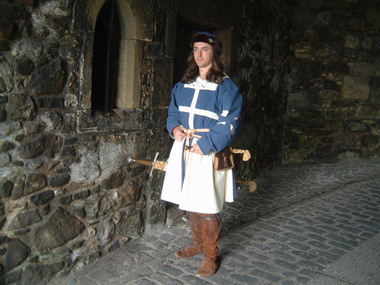
|
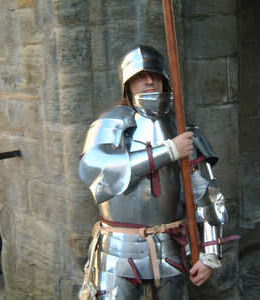
|
|
One of James' Captains wearing livery. |
A heavily armoured Man-at-Arms |
|
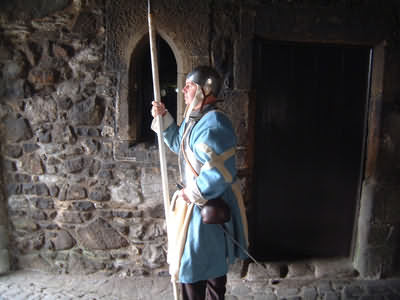
|
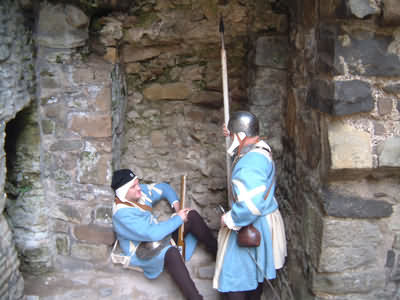
|
|
A Scottish Pikeman on guard duty. |
Two Scottish Soldiers relax while on garrison duty. |
|
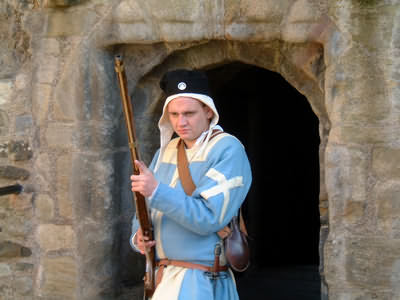
|
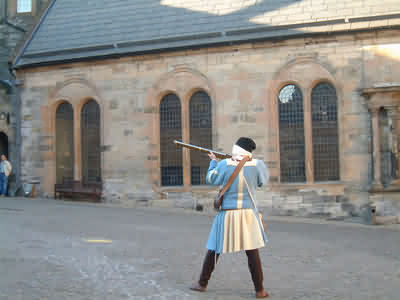 |
|
A Scots Hand-gunner wielding an arquebus |
A Hand-gunner practicing, safe within the walls of
Stirling Castle |
|
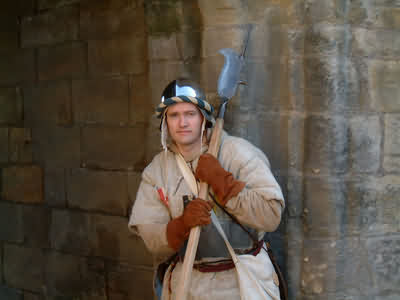
|
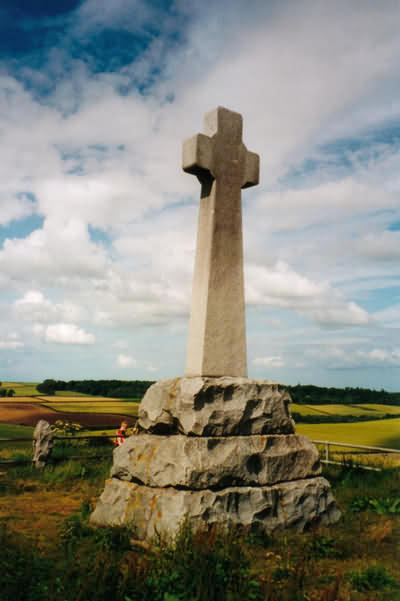
|
|
The opposition: An English Billman |
The Memorial on Flodden Field. |
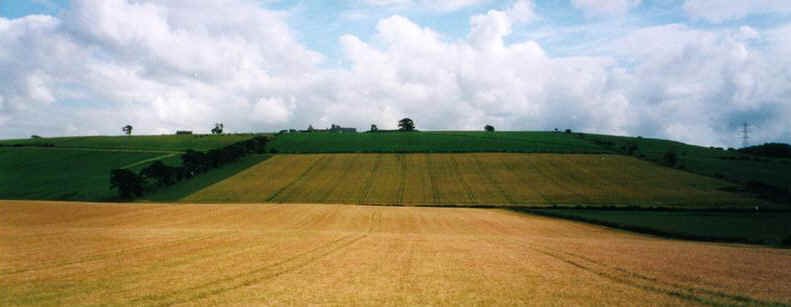
Flodden Field, looking from the English
position towards the Scottish Encampment.
[Back]





